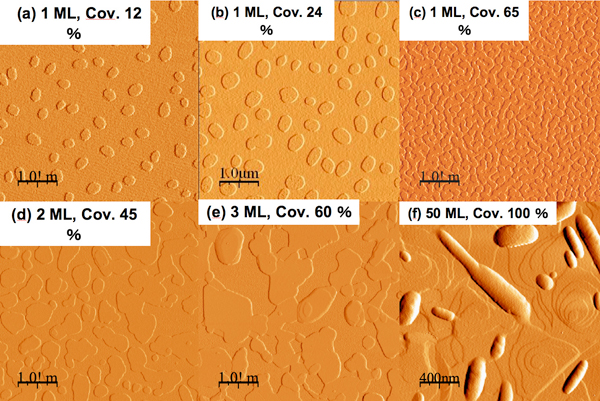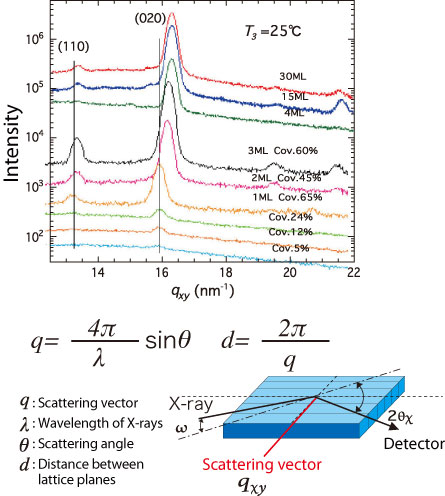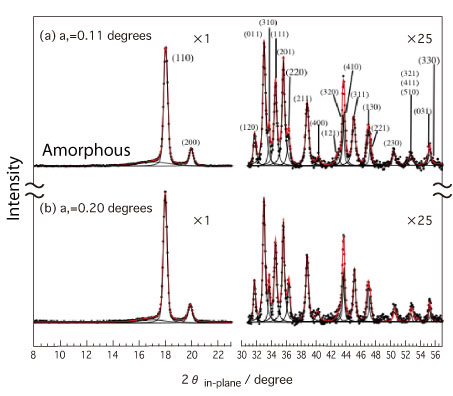Topic 9: Analyzing Nanosurfaces using Grazing Incidence X-ray Diffraction (GIXD)
Exploring Surfaces of Organic Thin Films at the Nanolevel
The surfaces of organic thin films and polymeric films have received increasing amounts of attention in the fields of organic molecules and polymers because the recent trend is that fields involving materials whose functions largely depend on the surface structure such as fields relating to organic thin film transistors (TFTs) are expanding. Moreover, in its ten year history, the research on surface structures of organic molecules and polymers has received varying degrees of attention, depending on their utilities at different scales from on the order of 1 nm to 10 nm (1 nm = 10-9 m). The structural evaluation of these nanosurfaces has been made possible due to the grazing incidence X-ray diffraction (GIXD) technique, which uses highly brilliant and directional X-rays available at SPring-8. In this topic, the following two studies are reported: (1) achievements in the explorative studies on the formation mechanisms of the crystal structures of organic semiconductor thin films and (2) achievements in surface structures of polymer films using GIXD.
GIXD - Evaluation Technique of Crystal Structures of Nanosurfaces
Because most materials have refractive indexes of X-rays slightly less than one, grazing incidence X-rays on a flat surface of a material results in total reflection. GIXD is a technique to measure the reflection, refraction, and diffraction of X-rays by slightly varying the incidence angle of X-rays around the total reflection angle. This technique can reveal the structures of materials within 10 nm from the surface as well as deeper structures distinctly at the atomic and molecular levels. Grazing incidence is also called small-angle incidence.
X-ray diffraction measurements are suitable to structurally evaluate thin films such as organic molecules and polymers because the samples do not have to be pretreated and X-ray radiation causes minimal damage. However, crystals of organic molecules and polymers have low X-ray scattering intensities. Thus, the detection of the intensity and peak width of faint scattered X-rays is impossible for X-rays with conventional intensities. Furthermore, highly directional X-rays are required to precisely control the incident angle. Hence, the highly brilliant and directional X-rays at SPring-8 are required for these measurements.
Changing the Mechanisms of Membrane Formation by Terminal Functional Groups
Devices comprised of organic semiconductors, e.g., TFTs, have many advantages such as being cost-efficient, lightweight, and flexible, but certain defects are common, including the creation of polycrystals whose molecular arrangements easily crack. Additionally, their crystal structures show variations and often exhibit a non-uniform electrical conductivity. Besides questioning the reproducibility, such defects make it difficult to increase the mobility of electrons or holes, which is a measure of the processing capacity of a device.
To overcome these issues, the molecular arrangements of crystal layers and the structures of thin films as well as the crystal growth mechanisms must be understood. Dr. Noriyuki Yoshimoto (Professor, Iwate University, Japan), Dr. Christine Videlot-Ackermann (Centre Interdisciplinaire de Nanoscience de Marseille (CINaM), France), Mr. Yoshiyuki Asabe (Alps Electric Co., Ltd., Japan), and colleagues at the Japan Science and Technology Agency (JST) Iwate have attempted to reveal the structures of organic thin films at the single molecule level. CINaM has synthesized derivatives of 30 types of organic molecules, and out of which they selected distyryl-oligothiophene (DS-nT) and its derivatives as target molecules because DS-nT has a relatively high mobility and long-term stability. In November 2006, GIXD measurements began at the Surface and Interface Structures Beamline (BL13XU), but were later moved to the Engineering Science Research III Beamline (BL46XU) because the thin film diffractometer was transferred there in 2007.
When DS-nT does not have a substituent, the second and third layers simultaneously form with the first layer of the molecular assembly (“island”). In contrast, when the substituents are hexyl groups (C6H13-), the second layer does not form until the first layer completely covers the plate, and the formation of the 3D crystalline structure is initiated as the second layer is formed. Figure 1 depicts these processes using atomic force microscope (AFM) images. The first layer grows in a 2D plane, but a 3D structure quickly appears as the second layer is formed. As shown in Fig. 2, the GIXD measurements of these processes reveal that the intermolecular distances decrease upon the formation of the second and subsequent layers, which can be observed from the position of the (020) peak. While forming the second layer, the island shows a remarkable dynamism. However, the formation processes of the first and second layers in samples without hexyl groups are the same. Their research has provided the first molecular level example of how the interaction between thin films and plates differs according to the terminal functional group, and consequently demonstrated that the formation mechanisms of membranes change. These experiments would not be possible without GIXD at SPring-8 to precisely observe the changes, including variations in intermolecular distances and the crystal structures from the first to second molecular layers (MLs).
As their research has progressed, it has been found that the crystal orientation anisotropy, or the variation in crystal structures, which is a disadvantage of organic crystals, can be converted to an advantage. “The existence of the island, which has various electromagnetic properties, indicates the possibility of the numerous different combinations,” explains Dr. Yoshimoto. Moreover, their research group has revealed the 3D crystal structures of organic semiconductor ultra-thin films in the early stage of crystallization as well as the molecular structures of thin films exhibiting desirable electric properties. Currently, their group is conducting real-time temporal observations of organic semiconductor molecules to unravel the mechanisms of aggregation and crystallization using GIXD.

a-c Islands with a single molecule thickness expand in-plane to cover the entire plate.
d-f Structures become 3D upon the formation of a second layer.

Data shows that the intermolecular distances and structures of the first molecular layer (ML) differ from those of second or higher ML. Horizontal axis, q, represents the amplitude of the scattering vector, which is related to the lattice spacing (distance between lattice planes), d, by equations shown in the figure. As q increases, the intermolecular distance decreases. For example, the lattice spacing in the (020) lattice is 0.39 nm in the first layer and 0.38 nm in the second and subsequent layers, indicating that the intermolecular distance decreases in the second and subsequent layers.
Exploring Problems in Polymer Thin Film Surfaces
In the fields of electronics and photonics, manufacturing technologies of thin films using organic molecules and polymers are advancing. It is not an exaggeration to say that thin films are mostly occupied by surfaces. Thus, the structures and physical properties of material surfaces greatly influence the functional properties of materials. Although several studies on the structural observation of a polymer surfaces have been reported for polyimide and polyethylene terephthalate (PET), similar studies using the most common polymer, polyethylene, were considered nearly impossible due to difficulties in sample preparation. However in 2002, Dr. Chisato Kajiyama1) (Professor, Kyushu University, Japan), Dr. Atsushi Takahara (Professor, ditto), Dr. Sono Sasaki2) (Assistant Professor, ditto), Dr. Osamu Sakata (Senior Scientist, Japan Synchrotron Radiation Research Institute (JASRI)), and colleagues challenged the impossible using the highly brilliant and direct X-rays at SPring-8 for GIXD.
Their research has revealed aggregation structures of polymer chains on polyethylene film surfaces. They prepared polyethylene thin films (about 400-nm thick) on silicon substrates by minimizing the film's surface asperity. After melting on the substrates, these films were annealed at arbitrary temperatures between 72 and 122 °C to control crystallization. At BL13XU, the diffraction intensity data were recorded with the grazing incidence at 0.11° for the surface regions (Fig. 3a) and at 0.20° for the inside (bulk) regions (Fig. 3b) to analyze crystal structures. Numerous sharp diffraction peaks were observed, and the GIXD measurements at SPring-8 definitely met their research group's expectations.
Examining the crystal lattice, which represents the molecular configuration in a crystal, has revealed that the lattice size in the surface region is smaller than that in the bulk regions, indicating that the intermolecular distances of the surface regions are smaller and the crystals are more densely-packed compared to the bulk regions. An organic polymer solid consists of a mixture of crystal and amorphous components; its low crystallinity is the cause of its poor strength. Their study has demonstrated that the crystallinity of the surface region is 12% smaller than that of the bulk regions.
Furthermore, investigating the orderliness of a crystal lattice in the in-plane direction of the surface region has revealed that the lattice arrangement contains considerable variation without a long-range order. It is presumed that the large heat dissipation and large degree of freedom of molecular motion in the surface region may induce an unstable environment for crystallization. Dr. Sasaki, who witnessed the significant analyzing power of synchrotron radiation and realized SPring-8 provides indispensible light to study the surfaces of polymeric thin films, has stated, “The aggregation states of polymer chains in the surface region sometimes determine their own physical properties and functions of thin film materials.”
Their research group is the first to reveal that the surfaces of polyethylene thin films have unique molecular aggregation structures on the nanolevel, and unlike the bulk regions, the surface regions have large deformations and displacements. These results were published in Macromolecules in 2003. Dr. Sasaki and colleagues are currently working on real-time high-speed time resolving measurements of structural changes using synchrotron radiation to reveal how polymer chains in the surface regions alter their structures according to various external stimuli such as temperature, humidity, light, and stress.
1) Currently the President at the Japan Student Services Organization.
2) Currently Associate Professor, Kyoto Institute of Technology.

Peak positions and widths of Bragg reflections reveal that the atomic arrangement in a crystal is more random near the surface a than inside b. Approximately 400-nm thick films are used in the measurements.
References
1. N. Yoshimoto, K. Aosawa, T. Tanisawa, K. Omote, J. Ackermann, C. Videlot-Ackermann, H. Brisset and F. Fages; Cryst. Res. Technol., 42, 1228 (2007)
2. H. Yakabe, S. Sasaki, O. Sakata, A. Takahara and T. Kajiyama; Macromolecules, 36, 5905 (2003)
3. H. Yakabe, K. Tanaka, T. Nagamura, S. Sasaki, O. Sakata, A. Takahara and T. Kajiyama; Polym. Bull., 53, 213 (2005)